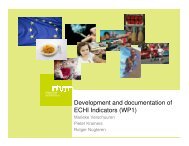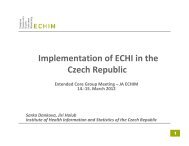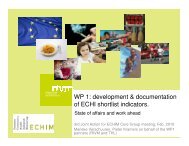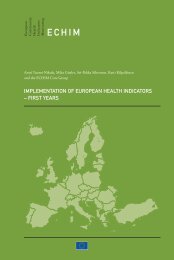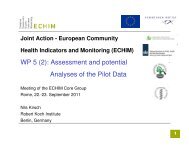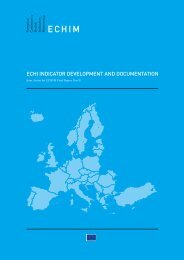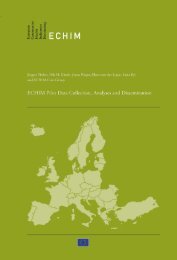INDICATORS
ECHIM Final Report
ECHIM Final Report
You also want an ePaper? Increase the reach of your titles
YUMPU automatically turns print PDFs into web optimized ePapers that Google loves.
Calculation: The indicator is calculated as the total number of physicians (medical doctors)<br />
in a given year, divided by the mid year population of that given year, expressed per 100 000<br />
inhabitants.<br />
Sub-categories of 1) practising, 2) professionally active, 3) economically active and 4)<br />
licensed to practise physicians per 100 000 inhabitants are calculated respectively, relating the<br />
total number of physicians in question to the mid year population.<br />
Notes: Practising, professionally active, economically active and licensed to practise<br />
physicians are defined according to the Eurostat document: “Definitions and data collection<br />
specifications on health care statistics (non-expenditure data) Version 31 July 2007”.<br />
Practising physicians provide services directly to patients. Professionally active physicians are<br />
practising physicians plus other physicians for whom their medical education is a prerequisite<br />
for the execution of the job. Economically active physicians are practising physicians,<br />
professionally active physicians as well as physicians who do not use their medical education<br />
for the purpose of their actual job. Physicians licensed to practise are practising physicians,<br />
professionally active and<br />
economically active physicians as well as all physicians being registered and entitled to<br />
practise as health care professionals.<br />
Absolute number of posts (PP; “head count”) versus number of full time equivalent (FTE)<br />
posts. The number of working hours per week varies between countries, but normally should<br />
not be less than 35 hours. The number of FTE should be calculated by adding the full and<br />
appropriate proportion of part-time occupied posts.<br />
64. NURSES EMPLOYED<br />
Definition: The indicator is defined as the total number of nursing and caring personnel (i.e.<br />
qualified nurses, midwives, associate nurses and caring personnel) per 100 000 inhabitants.<br />
A (qualified and associate) nurse is a person who has completed a programme of basic<br />
nursing education and is qualified and authorised in his/her country to practise nursing in<br />
all settings. A midwife is a person who has completed a midwifery educational programme<br />
duly recognised in the country in which he/she is located and who has acquired the requisite<br />
qualifications to be registered and/or legally licensed to practise midwifery. Caring personnel<br />
include e.g. nursing aids and assistants.<br />
Indicator can be divided into sub-categories of:<br />
1) practising,<br />
2) professionally active,<br />
3) economically active and<br />
4) licensed to practice nursing and caring professionals.<br />
Calculation: The indicator is calculated as the total number of nursing and caring personnel<br />
(i.e. qualified nurses, midwives, associate nurses and caring personnel) in a given year,<br />
divided by the mid year population of that given year, expressed per 100 000 inhabitants.<br />
Sub-categories of 1) practising, 2) professionally active, 3) economically active and 4)<br />
licensed to practise nursing and caring personnel per 100 000 inhabitants are calculated<br />
respectively, relating the total number of nursing and caring professionals in question to the<br />
mid year population.<br />
121



